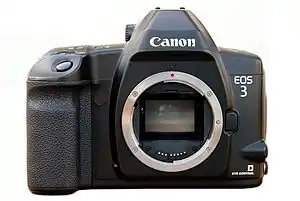Canon EOS-3
The Canon EOS-3 is a 35mm film single-lens reflex camera for professionals and advanced amateurs built by Canon of Japan. It was introduced in November 1998,[1] and was offered as recently as 2007.
 | |
| Overview | |
|---|---|
| Maker | Canon |
| Type | SLR |
| Released | November 1998 |
| Production | 1998-2007 |
| Lens | |
| Lens mount | Canon EF mount |
| Lens | Interchangeable |
| Sensor/medium | |
| Sensor type | Film |
| Sensor size | 24mm x 36mm; 35mm |
| Recording medium | 35mm Film |
| Focusing | |
| Focus | Manual Focus; Autofocus; Eye-controlled Auto-Focus |
| Focus modes | 1. One-Shot AF: Autofocus stops when focus is achieved. AF lock enabled. Shutter releases only when focus is achieved. 2. Predictive AF with Al Servo AF: Tracks subject movement up to the start of exposure. Predictive AF enabled. The shutter can be released at any time regardless of focus (predictive AF control takes effect during continuous shooting), no in-focus indicator (blinks at 8 Hz only if AF fails). 3. Manual focusing: Enabled with the focusing ring when the lens focus mode switch is set to MF (or M). 4. Full- time manual focusing: Enabled with the electronic focusing ring during continuous shooting (except during film exposure). 5. In- focus indicator: Lights in viewfinder and beeps. (Beeper can be disabled.) |
| Focus areas | 45-point autofocus |
| Exposure/metering | |
| Exposure modes | 1. Program AE(shiftable) 2. Shutter speed-priority AE ( in 1/3,1/2 or full stops, safety shift enable with Custom Function) 3. Aperture-priority AE (in 1/3,1/2 or full stops, safety shift enabled with Custom Function) 4. Depth-of-field AE 5. E-TTL program flash AE (high-speed sync, FE lock, and wireless control enabled with 550EX) 6.A-TTL program flash AE 7. TTL program flash AE 8. Manual 9. Bulb |
| Exposure metering | 0-20 EV (at 20°C / 68°F; with 50/1.4 lens, ISO 100) |
| Metering modes | TTL maximum aperture metering with a 21 zone silicon photocell 1. Evaluative2. Partial (8.5% of viewfinder at centre);3. Centre spot (approx. 2.4% of viewfinder at centre) 4. Spot metering (linked to focusing point at approx. 2.4% of viewfinder) |
| Flash | |
| Flash | Hot shoe compatible with: E-TTL autoflash, A-TTL autoflash, TTL autoflash |
| Shutter | |
| Frame rate | 4 frames/sec; 7 frames/sec with PB-E2 |
| Shutter | Vertical-travel, focal-plane shutter with all speeds electronically controlled. |
| Shutter speeds | 30 to 1/8000 sec in 1/3 stops; X-sync at 1/200 sec. |
| Viewfinder | |
| Viewfinder | Eye-level pentaprism |
| General | |
| Battery | 1. One 2CR5 lithium battery housed in the camera grip. 2. With Power Drive Booster PB-E2, 8 size-AA alkaline, Ni-Cd, or lithium batteries or Ni-MH Pack NP-E2. (Camera grip removed). 3.With Battery Pack BP-E1, 1 2 CR5 Lithium battery and 4 size-AA alkaline or Ni-Cd batteries(Camera grip removed) |
| Body features | Weather sealed body |
| Dimensions | 161 x 119.2 x 70.8mm |
| Weight | 780g (Excluding lithium battery) |
The camera is the successor to the EOS-5 but has a lot in common with the canon EOS-1n such as the operation of the camera controls and the environmental sealing, whereas the EOS-5 has none. The common heritage of the EOS-3 and EOS-1 line is also seen in the accessories (such as the motor-drive and battery pack) which are mostly the same or at least interchangeable.
The EOS-3 introduced the 45-point autofocus system later used in the EOS-1v, EOS-1D and subsequent Canon professional SLRs. It was the last camera outside the 1-series, either film or digital, to receive Canon's top-of-the-line AF system until the March 2012 announcement of the EOS 5D Mark III.[2]
The EOS-3 inherited a refined version of the Eye-Control system of the EOS-5. This system, when calibrated to a given user, allowed for picking one of the 45 points of the autofocus system simply by looking at it though the viewfinder. An infrared transmitter and receiver mounted around the eyepiece monitored the position of the iris, thus "knowing" where the user was looking and then focusing on that point. Notably, eyeglasses and occasionally contact lenses would confuse the system. This feature was never rolled forward to the later 1V body.
The shutter unit of the EOS-3 passed Canon's standard endurance tests of 100,000 shutter cycles whereas the EOS-1v was specified to withstand at least 150,000 shutter cycles.
The EOS-3 incorporated E-TTL flash metering for use with the EX series of external Canon flash units.
References
- Canon Inc. "EOS-3". Canon Camera Museum. Archived from the original on 2015-02-26. Retrieved 2007-02-06.
- Westlake, Andy; Butler, Richard (March 2012). "Canon EOS 5D Mark III Hands-on Preview: 1. Introduction". Digital Photography Review. Archived from the original on 2012-03-03. Retrieved March 2, 2012.
External links
 Media related to Canon EOS-3 at Wikimedia Commons
Media related to Canon EOS-3 at Wikimedia Commons- Canon USA EOS-3 Specification Page Archived 2015-10-11 at the Wayback Machine